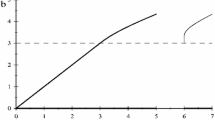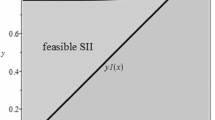Abstract
We study a discrete common-value auction environment with two asymmetrically informed bidders. Equilibrium of the first-price auction is in mixed strategies, which we characterize using a doubly recursive solution method. The distribution of bids for the ex post strong player stochastically dominates that for the ex post weak player. This result complements Maskin and Riley’s (Rev Econ Stud 67:413–438, 2000) similar result for asymmetric private-value auctions. Finally, comparison with the dominance-solvable equilibrium in a second-price auction shows the Milgrom–Weber (Econometrica 50:1089–1122, 1982a) finding that the second-price auction yields at least as much revenue as the first-price auction fails with asymmetry: in some cases the first-price auction provides greater expected revenue, in some cases less.
Similar content being viewed by others
References
Banerjee P (2005) Common value auctions with asymmetric bidder information. Econ Lett 88: 47–53
Campbell C, Levin D (2000) Can the seller benefit from an insider in common-value auctions?. J Econ Theory 91: 106–120
Cheng HH, Tan G (2010) Asymmetric common-value auctions with applications to private-value auctions with resale. Econ Theory 45: 253–290
Einy E, Haimanko O, Orzach R, Sela A (2001) Dominant strategies, superior information, and winners curse in second-price auctions. Int J Game Theory 30: 405–419
Einy E, Haimanko O, Orzach R, Sela A (2002) Dominance solvability of second-price auctions with differential information. J Math Econ 37: 247–258
Engelbrecht-Wiggans R, Milgrom P, Weber R (1983) Competitive bidding and proprietary information. J Math Econ 11: 161–169
Hardy GH, Wright EM (1989) An introduction to the theory of numbers, 1938, 5th edn. Oxford University Press, Oxford
Hausch DB (1987) An asymmetric common-value auction model. Rand J Econ 18: 611–621
Hörner J, Jamison J (2008) Sequential common-value auctions with asymmetrically informed bidders. Rev Econ Stud 75: 475–498
Jackson M (1993) Bayesian implementation. Econometrica 59: 461–477
Kagel JH, Levin D (1999) Common value auctions with insider information. Econometrica 67: 1219–1238
Kalman D, Mena R (2003) The Fibonacci numbers—exposed. Math Mag 76: 167–181
Laskowski MC, Slonim RL (1999) An asymptotic solution for sealed bid common-value auctions with bidders having asymmetric information. Games Econ Behav 28: 238–255
Larson N (2009) Private value perturbations and informational advantage in common value auctions. Games Econ Behav 65: 430–460
Lizzeri A, Persico N (2000) Uniqueness and existence of equilibrium in auctions with a reserve price. Games Econ Behav 30: 83–114
Malueg DA, Orzach R (2009) Revenue comparison in common-value auctions: two examples. Econ Lett 105: 177–180
Maskin E, Riley J (2000) Asymmetric auctions. Rev Econ Stud 67: 413–438
Milgrom P (1981) Good news and bad news: representation theorems and applications. Bell J Econ 12: 380–391
Milgrom P, Weber R (1982a) A theory of competitive bidding. Econometrica 50: 1089–1122
Milgrom P, Weber R (1982b) The value of information in a sealed-bid auction. J Math Econ 10: 105–114
Moulin H (1986) Game theory for the social sciences. New York University Press, New York
Myerson R (1981) Optimal auction design. Math Oper Res 6: 58–73
Parreiras SO (2006) Affiliated common value auctions with differential information: the two bidder case, contributions to theoretical economics, vol. 6. Berkeley Electronic Press, Berkeley
Riley J, Samuelson W (1981) Optimal auctions. Am Econ Rev 71: 381–392
Rodriguez GE (2000) First price auctions: monotonicity and uniqueness. Int J Game Theory 29: 413–432
Vohra R (1999) Incomplete information, incentive compatibility and the core. J Econ Theory 86: 123–147
Wang R (1991) Common-value auctions with discrete private information. J Econ Theory 54: 429–447
Weisstein E. Reciprocal Fibonacci constant, from Mathworld—A Wolfram Web Resource. http://mathworld.wolfram.com/ReciprocalFibonacciConstant.html
Weverbergh M (1979) Competitive bidding with asymmetric information reanalyzed. Manage Sci 25: 291–294
Wilson R (1967) Competitive bidding with asymmetric information. Manage Sci 13: 816–820
Author information
Authors and Affiliations
Corresponding author
Additional information
While retaining responsibility for any errors, the authors thank Steven Matthews, William Neilson, Sergio Parreiras, Dov Samet, Yair Tauman, participants in the 2009 Stony Brook International Summer Festival on Game Theory, and two anonymous referees for their comments on earlier versions of this paper.
Electronic Supplementary Material
The Below is the Electronic Supplementary Material.
Rights and permissions
About this article
Cite this article
Malueg, D.A., Orzach, R. Equilibrium and revenue in a family of common-value first-price auctions with differential information. Int J Game Theory 41, 219–254 (2012). https://doi.org/10.1007/s00182-011-0282-x
Accepted:
Published:
Issue Date:
DOI: https://doi.org/10.1007/s00182-011-0282-x




